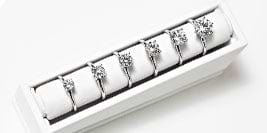Have you ever thought about the price of a Earth mined diamond beyond its monetary value? Sure the 4Cs are important to understand when purchasing a diamond as that is how the cost of the diamond is determined. But beyond the 4Cs and monetary cost, there is a huge price that is paid for all that natural sparkle. At MiaDonna we refer to this cost at the 5th C - conflict.
It’s hard to imagine that in 2018 conflict diamonds are still a problem, but if you stop to think about it, are you really surprised that they are? We live in a time where everything is disposable from consumer goods to the lives of the people producing these products. Sure you might think twice before buying fur, factory farmed meat or even shopping at big name retailers using child labor to create your favorite shoes or clothes - but what about that diamond on your finger?
According to Bain & Company, about 133 million carats of rough diamonds are mined each year - with 65 percent of them originating from Africa. Then consider the fact that only 1 in 4 (25%) of diamond mines in Africa are well regulated, we can assume 3 of every 4 diamonds mined in Africa has a history of environmental and humanitarian abuses. This equals nearly 65 million diamonds that are hitting the international diamond market each year, or at least 1 in 13 diamonds on the international market coming from a conflict origin.
While diamonds are loved internationally - The U.S. was the main growth market for diamond jewelry sales in 2016 and accounts for nearly half of all demand worldwide. In a CNBC article, Alice Harle, an expert on minerals from the nonprofit organization Global Witness, shared that the "conflict diamond problem has not gone away. Companies sourcing diamonds originating in countries like Central African Republic and Zimbabwe may risk indirectly supporting violence."
In fact, Human Rights Watch release a report in February 2018 scrutinizing “steps taken by key actors within the jewelry industry to ensure that rights are respected in their gold and diamond supply chains.” The report highlights the varying policies and practices of 13 major jewelry brands in their efforts, and failures, to responsibly source their diamonds. Let’s take a closer look…

Zimbabwe
Zimbabwe is a nation notoriously known for its poverty-stricken population, corrupt government and conflict diamond mining. Time has proven that little resolve has occurred to alleviate these issues and that in fact, they continue to worsen.
Global Witness, an anti-corruption campaign group, recently released a report stating that the funds from diamond exports have been used to finance Zimbabwe’s Central Intelligence Organization (CIO). It is important to note that the CIO is known for committing human-rights abuses and is largely responsible for keeping President Robert Mugabe in power for decades.
One of the leading problems in the filtration of these funds is the Kimberley Process Certification Scheme (KPCS). While it claims to facilitate a conflict-free diamond trade, it fails to do just that. The loose rules of the KPCS allow diamonds to be labeled as “conflict-free” so long as their profits do not fund armed forces. Nonetheless, these diamonds can still be considered “ethically sourced” regardless of the human-rights abuses miners endured to collect these gemstones.
According to “An Inside Job,” $2.5 billion worth of diamonds were officially exported from Zimbabwe since 2010. The devastating truth is that of that total, only $300 million returned to support the country. So long as this land continues to be heavily excavated and the unearthed diamonds are traded through both official and unofficial channels, the funneling of money to the corrupt CIO will go on endlessly. It is not likely that we will ever see an accurate account of these funds and where they are routed.
Central African Republic
A Forbes article from early 2017, brought to our attention that conflict diamonds from the Central African Republic (CAR) have found their way to Facebook’s online marketplace. “According to an investigative report by Global Witness, an NGO that works to fight natural resource exploitation. Illegal digital activities were unveiled through a social media profile for a fictitious buyer. The organization found that messenger platforms such as WhatsApp have also been used as a tool to smuggle conflict stones into the international supply chain.”
It’s easy to see how these atrocities can happen. In places like the Central African Republic (CAR), where the Kimberley Process implemented a ban in 2013, diamonds have continued to fund wars that have killed thousands. According to a U.N. panel of experts conflict diamonds are still being smuggled out of the CAR, with an estimated value of $24 million, that’s approximately 140,000 carats of conflict diamonds flooding the market despite the ban. In a June [2015] report the Enough Project found that the majority of smuggled diamonds are first taken to Cameroon, the Democratic Republic of the Congo, and Sudan before they are released into international markets. They also estimate that through taxation and illegal diamond trade rebel groups raise $3.87 million to $5.8 million a year, funding their continued terror.
India
According to international trades unions, the worst child labor violations in the diamond industry are happening in India; where it has been estimated that more than 20 percent of those employed are children. That is approximately 20,000 workers, ages 12 and younger, who are forced to work in abhorrent conditions for low wages polishing diamonds. These children work long hours in overcrowded, badly ventilated workshops leading to chronic joint issues and lung disease, often crippling them before they even reach adulthood.
Israel
Diamond companies in Israel directly and indirectly fund a military regime guilty of grievous human rights violations; claim their diamonds are conflict-free. The RJC (Responsible Jewelry Council), which employs the Kimberley Process, doesn’t consider Israel/Palestine a “conflict-affected area”, despite being a region where a diamond-funded regime holds brutal control over the indigenous Palestinian population with relentless human rights violations for over 60 years. Allowing cut-and-polished blood diamonds to evade all legal sanction and freely enter the legitimate markets - generating revenue from estimated to provide $1billion per year to the Israeli military, which has been accused of war crimes.
Venezuela
Conflict diamonds remain a problem in several South American countries such as Brazil and Venezuela. In fact, Venezuela “voluntarily” withdrew from the Kimberley Process for two years starting in 2008 following the threat of expulsion for noncompliance with basic requirements, such as wholesale smuggling. Following this, there has been little evidence of Venezuela forming any serious efforts to address concerns. Diamond mining and smuggling continue unchallenged, yet the Venezuelan government persists in its aggressive stance toward civil society groups to report it. The Kimberley Process will be expected to require that Venezuela demonstrate it has instituted the necessary reforms to become compliant. For years now, there have been no official diamond exports from Venezuela despite an active mining sector. Therefore, all Venezuelan diamonds are labeled as being smuggled illegally, yet the country remains compliant with the Kimberley Process.
Nambia
Conflict diamonds are without-a-doubt full of human rights violations, but the conflict doesn’t stop with just people - the environment in which these diamonds are being extracted should also be considered. Nambia is just one example. “Mining companies are having to dig deeper and mine in more remote locations to keep up with demand. Along the way, they are destroying wild habitats and fragile eco-systems more than they ever have before. A prime example of this is De Beers’ operation with the Nambian government. They own more than 3,000 square miles of Nambian seafloor and are using technology to extract underwater diamonds...This deep-sea mining is harming both the Earth and sea life to an extent that could be irreparable. A concern is that underwater environments are being destroyed before new species are even discovered. De Beers combated these statements by saying that the returned sediment eventually re-settles and does not cause significant damage. That’s just not true. Wildlife and ecosystems are being killed and forced to rebuild.”
Botswana
While many would lead you to believe Botswana is an “African miracle”, avoiding the resource curse with their abundance in diamonds and stable government. One thing is for certain, diamond mines are not forever. Botswana needs to diversify and figure out how to move away from its dependence on diamonds -- “a calculation that has been given greater impetus by economic slowdowns in China and India, which are both key markets for the stones.” Not to mention that decades of geological surveying has confirmed that Botswana’s diamonds are becoming scarce, with forecasters estimating mines will dry up in roughly 20 years.
Angola
Angola is known for its traditional ethnic art, textiles, and amazing scenery. Award winning author and journalist Rafael Marques de Morais exposed hundreds of cases of murder, torture, mutilation, rape and corruption linked to the diamond industry within this country. In 2011, his book Blood Diamonds: Corruption and Torture in Angola, documented the link between generals in the Angolan military and government ministers, shareholders in mining and security companies that have committed brutality on the diamond mining district of Lundas. As of 2011, Angolan diamonds were mainly exported to destinations such as Dubai (47%), Israel (22%), and Switzerland (19%). Back in 2013, in a address to the EU Parliament Subcommittee on Human rights de Morais remarked, “Diamonds being mined today in Lundas are no less bloody than those that funded past wars. Today, my people are being assassinated not to fund a civil war, but out of sheer greed and malignancy.” When Angola chaired the Kimberley Process back in 2015, de Morais was persecuted for defaming the generals. He was given a six month suspended jail sentence. Despite the obvious link between the diamond industry, corruption and human rights violations, diamonds from Angola are in full compliance with the Kimberley Process and the Responsible Jewelry Council Code of Practices (RJC COP).
Congo
In February 2017, the Trump administration prepared a new executive order which would extinguish regulatory controls designed to prevent US companies profiting from and encouraging the spread of “conflict minerals,” which provoke violence in Congo. A draft executive order, proposed a two-year suspension of a portion of the Dodd-Frank Wall Street Reform and Consumer Protection Act. This US federal law placed regulation on the financial industry in the hands of the government, requiring US firms to carry out due diligence to ensure the products they sold included no minerals mined in the Democratic Republic of the Congo or any other neighboring countries.
The regulation was widely applauded as a foundation of attempts to cut the ties between big business and violent warlords who have spread turmoil throughout the Congo and caused the deaths of more than 5 million people since the 1990s. The draft order states that it is temporarily scrapping the rule, found in section 1502 of the Dodd-Frank financial reforms that was initially introduced in 2010, for the concern of human rights in the Congo. Where it alleges there is mounting evidence that the obligation on US firms to validate to regulators that they are not involved in blood minerals has “caused harm to some parties in the DRC and have thereby contributed to instability in the region and threatened the national security interest of the United States”. It continues on to say, “this Executive Order recognizes that humanitarian missions play an important role in the President’s responsibility to defend the national security interests of the US.” However, international aid groups working with the Congolese victims of conflict minerals disagree with the proposal. Their reasoning is that it’s far from being a humanitarian measure and would instead encourage armed groups and shameless businesses conspiring with them.
Global Witness, which has investigated the role of mining in fueling violence in eastern Congo for year, stated, “This law helps stop US companies funding conflict and human rights abuses in the DRC and surrounding countries. Suspending it will benefit secretive and corrupt business practices.” Under further inspection by Global Witness’s analysis, contrary to the draft’s allegation that the Dodd-Frank regulation had increased instability in the region, responsible business practice was beginning to spread in eastern Congo. Therefore, “This action could reverse that progress. It is an abuse of power that the Trump Administration is claiming that the law should be suspended through a national security exemption intended for emergency purposes. Suspending this provision could actually undermine US national security.”
Sierra Leone
In 1961, Sierra Leone gained independence from Great Britain. It wasn’t until after gaining its independence that diamond smuggling became a political problem as well as an economic one. In 1968, populist Siaka Stevens became prime minister, which brought the country to a one-party ruler. Stevens was the first person to officially connect the diamond mines to political power and found profit. Where he furthermore encouraged illicit diamond mining within Sierra Leone. By 1991, Sierra Leone had a corrupt government and openly illegitimate diamond trading was a vulnerable and attractive site for armed rebellion.
On March 23, a civil war began when the Revolutionary United Front (RUF), a group of 100 fighters from Sierra Leone and Liberia, invaded eastern Sierra Leone. Civil war lasted for nine years, all fighting was concentrated in and around the diamond districts. RUF leaders were aware that whoever controlled the diamond mines would then control Sierra Leone, and the profits from smuggled diamonds funded its attack. In July 1999, Foday Sankoh, an ex-army sergeant who led the RUF, and Sierra Leone’s president, Ahmed Tejan Kabbah, signed the Lome Peace Accord under pressure from the UN and the US government. RUF agreed to surrender its forces for a share in Sierra Leone’s government. As a compromise to RUF, Sankoh was released from the death sentence he earned for his war crimes and named chairman of the Strategic Mineral Resources Commission, a position that controlled most of Sierra Leone’s diamond exports. However, this was a short peace.
On January 6, 2000, just seven months after it was signed, RUF revived its attacks on Freetown and Sierra Leone’s government. Despite its previous promises to surrender its forces, RUF never followed through. Today, Sierra Leone is once again battling RUF, and control over the diamond mines is still at the center of the conflict. Ultimately, the UN has been forced to issue a ban on non-governmental diamonds for Sierra Leone.The country has suffered terrible social and economic costs as a result of its civil war and the never-ending fight over diamond control. Under the cover of warfare, the rebels committed heinous crimes against humanity in the forms of murder, rape, and mutilation. The war between 1991 and 1999 claimed over 75,000 lives, caused 500,000 Sierra Leoneans to become refugees, and displaced half of the countries 4.5 million people. It was during this time period the Sierra Leone economy was most vulnerable to being cheated out of millions of dollars in the form of illegal diamonds.
This may be hard to believe, but there are no laws in place banning conflict diamonds from being sold on the international market. To help it sink in, I’ll say it another way, the trade of conflict diamonds is fully legal. Yes, I said legal. Sure, there is the Kimberley Process which prohibits the trade of conflict diamonds, but with its limited definition and corrupt policies there’s no recourse for the sale of known conflict diamonds. Leaving us back where we started... asking ourselves, why in 2018, are conflict diamonds still a problem? The answer may be hard to hear, but the reason conflict diamonds are still a problem is because unknowing consumers keep purchasing them and not asking questions about their origin. It’s no secret that earth-mined diamonds are a big-time, bottom line enhancing, money-making commodity, that big business has been taking advantage of for too long. They continually value short-term financial gains over the long-term cost to the people and planet. And this is no longer acceptable! The time has come to change, since we now know better and consumer choice gives us the power.
The truth is, it’s been a decade since the term blood diamond entered the public domain, and the hard facts show that there is still essentially no way to be sure that the diamond you’re purchasing doesn’t have blood on it. Only you can stop the conflict, by removing yourself from the chain of command; purchasing lab grown diamonds are the only way to be sure you are not part of the problem, rather part the solution.





























